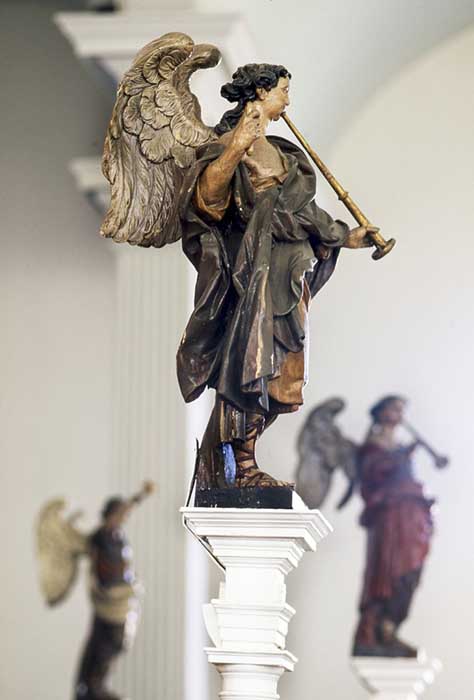The Real Story Behind Thomas Gruchy and His Stolen Angels – Part 1

By Tom Dietzel
Perched upon the gallery railing in front of the oldest American-built pipe organ, high above the floor of Old North Church, there are four hand-carved angelic figures. They each stand about two feet tall and in a triumphant pose. Two of the angels blow trumpets, while the other two greet onlookers with open arms. These four figures are celebrated features of Old North and a favorite among visitors and staff alike. The story surrounding the angels is well-publicized, and in one visit to Old North, a guest will most assuredly hear it told by an educator. The short version, the version read in most guidebooks and told by most tour guides, is this: In 1746 the angels were captured from a French ship on its way to a Catholic church in Quebec when the ship was intercepted by British privateer Thomas Gruchy, a member of Old North Church.
Often, the word privateer confuses many visitors. Often, many tour guides and educators simplify the word privateer to mean “legalized pirate.” It seems odd that an Anglican congregation, whose parishioners were primarily merchants, would allow a pirate into their midst. Furthermore, it is odd that a religious organization would not only condone such activity but would benefit from it. In order to get a clearer understanding of the angels and their coming to Old North, it is necessary to look at the world at the time of their capture. A detailed examination of the rise of privateering, the political and religious rivalries of the British and French, the congregation, and the man awarded the credit for their capture will show a much more broad history. It is as if these four angels could all by themselves tell us about the first half of the eighteenth century.
The angels are supposed to predate Old North by approximately one century. While there is not an exact date on the figures, it is believed they were carved in the early seventeenth century in what is now Belgium, then still ruled in part by France (the territory became part of the United Kingdom of the Netherlands upon the defeat of Napoleon; independence was declared in 1830). As a part of France, under the rule of a Catholic monarch, trade goods would flow freely between Belgium, the Netherlands, and their colonial possessions in North America, which of course, included much of Canada west of Nova Scotia, a key British possession. At the turn of the eighteenth century, the North American continent was a huge piece of imperial opportunity for the age-old rivals of Europe. The Atlantic Ocean, Caribbean and Mediterranean Seas, and the northeast coast of North America were all battlefields, with more years at war than at peace.
The French had settled the area starting in 1605 and the area is known as The Acadian Peninsula, now Nova Scotia was a hotly contested piece of real estate as of the 1630s when Scottish colonists began to settle. (‘Nova Scotia’ translates to English as ‘New Scotland’) While there was some fighting between the French and the Scots, the heaviest fighting began with the British Conquest of Acadia in 1710. The Acadian Peninsula controlled access into New France, thus a British presence threatened French mercantile and military opportunities. Over the next forty years, this area would be the primary point of contact for the French and British militaries. Throughout the eighteenth century, there was Queen Anne’s War (1702-1713), Father Rale’s War (1722-1725), King George’s War (1744-1748), Father Le Loutre’s War (1749-1755), and the French and Indian War (1754-1763). With this constant threat of war, or the state thereof, colonists loyal to either sovereign nation started to regard the colonists and subjects of their enemies with extreme distrust, dislike, and they were happy to war against one another for pride, land, money, trade routes, etc.
The particular conflict of interest in relation to our angels is King George’s War. Britain had been fighting The War of Jenkins’ Ear against the Spanish in the Caribbean and around Florida when the Austrian throne fell into the contest. The War of Austrian Succession did not actively involve Great Britain at first, but as Britain allied herself with Austria she simultaneously declared herself an enemy to France in the conflict. These tangled alliances brought Britain and France to hostilities in 1743 and a declared state of war in 1744. These wars can be analyzed by their strategy: hinder the enemy’s trade and crumble their economy. The economic pressure that would be felt by a nation losing such a war would be devastating. Fortresses were built at key locations and capitals, infantry would fight on those fields, but being that the primary objective was the obstruction of commerce, the real source of power was naval superiority. This posed one major problem for either of the warring nations, however; the deployment of ships in one area would ultimately leave another area vulnerable. The most common way of supporting a military in colonial territories was to turn to the colonists themselves for support.
